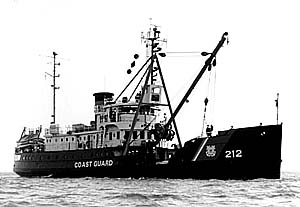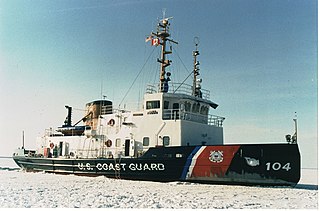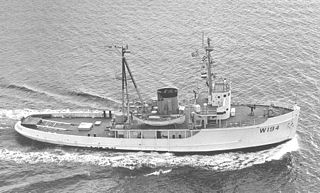
USS Zuni (AT/ATF-95), a Cherokee-class fleet tugboat, formerly called Navajo class, was a ship of the United States Navy named for the Zuni, the popular name given to a tribe of Pueblo Indians indigenous to the area around the Zuni River in central New Mexico near the Arizona state line.
The Medium Endurance Cutter or WMEC is a type of United States Coast Guard cutter mainly consisting of the 270-foot (82 m) Famous- and 210-foot (64 m) Reliance-class cutters. These larger cutters are under control of Area Commands. These cutters have adequate accommodations for crew to live on board and can do 6 to 8 week patrols.

USCGC Mellon (WHEC-717) is a United States Coast Guard Hamilton-class high endurance cutter based out of Seattle, Washington.

USCGC Reliance (WMEC-615) is a United States Coast Guard medium endurance cutter. She is the first of the 210' Medium Endurance Cutter Fleet and the fourth Revenue Cutter / Coast Guard Cutter to bear the name Reliance. Constructed by Todd Shipyards in Houston, Texas and commissioned in 1964, she was originally homeported in Corpus Christi, Texas. Her duties included offshore oil rig inspections, fisheries, counter drug, alien migrant interdiction, marine pollution patrols, and search and rescue. Reliance has been homeported in Yorktown, Virginia, Port Canaveral, Florida and New Castle, New Hampshire. She is currently stationed at the Portsmouth Naval Shipyard in Kittery, Maine.

USCGC Vigorous (WMEC-627) is a United States Coast Guard Reliance Class medium endurance cutter.

USNS Vindicator (T-AGOS-3) was a United States Navy Stalwart-class modified tactical auxiliary general ocean surveillance ship that was in service from 1984 to 1993. Vindicator then served in the United States Coast Guard from 1994 to 2001 as the medium endurance cutter USCGC Vindicator (WMEC-3). Since 2004, she has been in commission in the National Oceanic and Atmospheric Administration (NOAA) fleet as the oceanographic research ship NOAAS Hi'ialakai.
USS Bastion (ACM-6) was a Chimo-class minelayer in the United States Navy during World War II.

The United States Coast Guard Cutter Fir was the last lighthouse tender built specifically for the United States Lighthouse Service to resupply lighthouses and lightships, and to service buoys. Fir was built by the Moore Drydock Company in Oakland, California in 1939. On 22 March 1939, the U.S. Lighthouse Tender Fir was launched. She was steam driven with twin screws, 175 feet (53 m) in length, had a beam of 32 feet (9.8 m), drew 11 feet 3 inches (3.43 m) of water, and displaced 885 tons. Fir was fitted with a reinforced bow and stern, and an ice-belt at her water-line for icebreaking. She was built with classic lines and her spaces were lavishly appointed with mahogany, teak, and brass. The crew did intricate ropework throughout the ship. The cost to build Fir was approximately US$390,000. Fir's homeport was Seattle, Washington for all but one of her fifty one years of service when she was temporarily assigned to Long Beach, California when USCGC Walnut was decommissioned on 1 July 1982.

USCGC Wachusett (WHEC-44) was an Owasco class high endurance cutter built for World War II service with the United States Coast Guard. She was commissioned too late for service in that war and consequently did not see wartime service until the Vietnam War.
USCGC Tampa has been the name of four cutters of the United States Revenue Cutter Service and United States Coast Guard:

The second USS Wampanoag (ATA-202), originally USS ATA-202, was a United States Navy auxiliary ocean-going tug in commission from 1945 to 1947.
For United States Navy ships of the name, see USS Chincoteague.

USCGC Biscayne Bay (WTGB-104) is a United States Coast Guard Cutter and an icebreaking tug. She is based at Coast Guard Station St. Ignace with a primary area of operation in the Straits of Mackinac including Mackinac Island, Mackinac Bridge, and the northern portions of Lakes Michigan and Huron and occasionally Lakes Superior, Erie and their connecting rivers. Beyond her role as an icebreaker, Biscayne Bay performs search and rescue and law enforcement functions.

The Coast Guard Museum Northwest is dedicated to preserving the heritage of the United States Coast Guard in the Pacific Northwest. The museum is located on the property of Coast Guard Station Seattle on the Elliott Bay waterfront south of Downtown, Seattle, Washington. It covers the full range of Coast Guard roles, ranging from protecting shores, lives and property to lighthouses and lightships, from life-saving stations to rescue boats, from buoy tenders to icebreakers and weather ships and from modern aircraft to patrol boats and cutters. The museum admittance is free of charge.

The auxiliary ocean tug USS ATA-194 was laid down on 7 November 1944 at Orange, Texas, by the Levingston Ship Building Co.; launched 4 December 1944; and commissioned at Orange on 14 February 1945, Lieutenant (j.g.) William J. Bryan in command.
USCGC Tupelo WAGL/WLB-303, was a Cactus (A) Class 180 foot buoy tender built by Zenith Dredge Company of Duluth, Minnesota. Her keel was laid 15 August 1942, launched 28 November 1942 and commissioned on 30 August 1943. She was built as a WAGL and redesignated a WLB in 1965.
USCGC Catenary (WYTL-65606) was a cutter in the United States Coast Guard (USCG). Constructed by the Gibbs Gas Engine Company and commissioned in early 1962, the vessel served as part of the USCG for over 30 years before being decommissioned in mid-1995 and sold to the United States Merchant Marine Academy. During her service Catenary was based primarily on the east coast of the United States where she was utilized mainly in a law enforcement role.
USS Tamaroa (AT-62) was a U.S. Navy tugboat which served from 1936 until she was sunk in a collision in 1946. She is not to be confused with the U.S. Coast Guard Cutter USCGC Tamaroa (WMEC-166).














